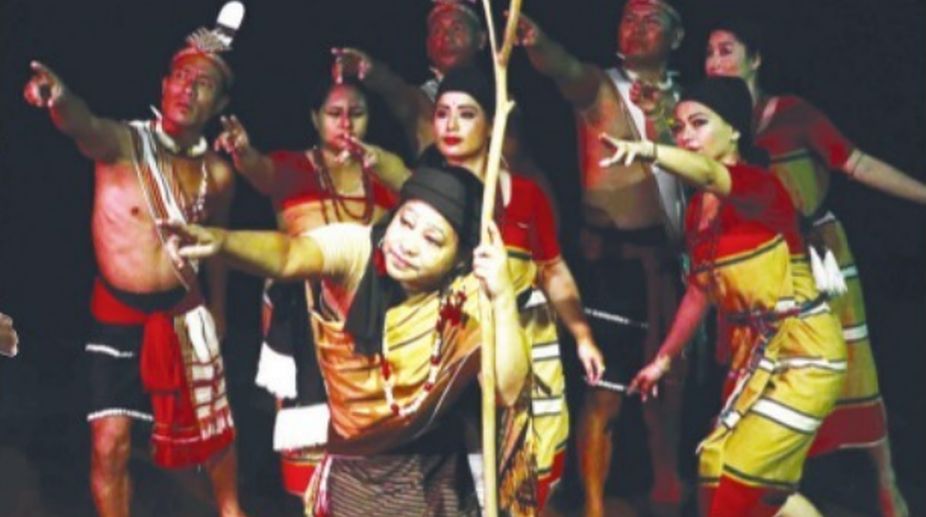Jawaharlal Nehru Manipur Dance Academy, Imphal, which is a constituent unit of Sangeet Natak Akademi, New Delhi, held its inaugural show, Kuranga Nayani, a six-scene dance drama, at Imphal’s Maharaj Chandrakirti Auditorium recently. Najma A Heptulla, Governor of Manipur and chairman of JNMDA, and H Tombi Singh, vice-chairman, JNMDA, graced the function as chief guest and president respectively.
Kuranga Nayaniwas based on the history of Assam scripted by the versatile genius Debjani Chaliha and choreographed and directed by the veteran Th Chaotombi Singh who has honed his choreographic skills from Maya Rao. Some of his memorable and widely-acclaimed choreographic works are Keibul Lamjao and Abhisarika among others. The choreographer confessed that in this production he faced some limitations since apart from using the native elements of Manipur, he also had to take into account elements of Assamese culture. Singh, therefore, needed to depend on dance-movements and aesthetics of some Indian cultural traditions. And he became more than aware of his limitations but they were not visible anywhere.The dance drama was a thumping success in every respect and that was made possible with excellent light design by L Ibochouba Singh and the music of Ng Ibopishak Singh.
Advertisement
Kuranga Nayani is a story depicting the bond of friendship between the people of Manipur and Assam. When Manipur was attacked by Burma, King Joy Singh of Manipur sought the help of Swargadeo Rajeswar Singh, the Ahom monarch. With the help of the regiment of Axom, the battle of Latakata ron was won by Manipur. The victorious King Joy Singh contracted a marriage alliance with the King of Assam and gave his daughter’s hand in marriage to Swargadeo Rajeswar Singh. Kuranga Nayanibecame the grand queen or Borkuwari of Ahom with her charming qualities. She was respected by the Assamese people for her patriotism towards Assam.
But her marital happiness was shortlived because Swargadeo Rajeswar Singh died early and his brother Lakshmi Singh ascended the throne only to be attacked, defeated and imprisoned by the Morans. Ragho, the chief executive of the Morangs, fell for Kuranga Nayani and married her by force. The enraged Assamese people wanted to throw the Morangs out of their land. Kuranga Nayani herself hatched a plan and played a trick on Ragho Borbaruah. On the day of Bahag Bihu, which takes place on the last day of Chaitra, she summoned him under a pretext to meet his subjects, who were supposedly loyal to him and wanted him as their king. He went unarmed and as he bowed down to greet them, he was killed. The Morangs were driven away in the Mowamariya war and peace returned to Ahom. Kuranga Nayani is remembered as the Mogulu-Kuwari. The pond, Mogolu Jiyori Pukuri, named after her, exists to this day in Rongpur, which is now known as Shibsagar.
The choreographic work was spectacular from start to the finish and the battle scenes were deftly executed by showcasing Manipur’s martial art, Thang ta. The scene that followed with the procession of Khiruk — bridal gifts in several richly decorated baskets along with the princess Kuranga Nayani and her entourage consisting many — was visual grandeur. The thoughtful choreographer gave the audience a glimpse into the land of Kuranga Nayani as her entourage passed. Rich folk dances and agricultural activities of village folk were indicative of the route taken. People stood in awe on seeing the royal procession.
But the landscape totally changed when they reached Assam. The richly adorned king’s court had huge motifs of sarai and the indigenous dances of Assam displayed a finely-researched work. There was of course Bihu dancing too. With great dignity and grandeur, the richly attired Kuranaga Nayani reached the palace of her royal groom. In the traditional style of a Manipuri wedding, she walked around the groom in the basic chali movement and presented him with a sword as per custom. Thereafter the bride and groom exchanged garlands. The king followed it up by crowning her queen with the subjects chanting Joyo joyo Maharani Kuranga Nayani. A Jugal nach ended the scene. The brutal Morang tribe’s attack was in an improvised style with a profusion of Thang Ta movements.
The queen in the meanwhile was seen mourning the death of her husband and her dream sequence was marked by poignancy. The darkest part of Kuranga Nayani’s life was no less tragic when she was forcefully married to the Morang chief. The emoting of her disgust was done with great stylisation. The chief’s endeavour to please his wife through the Butterfly dance, popular with the Morang tribe, was perfect.The adventures of Kuranga Nayani were seen in the act of getting rid of the Morangs and re-establishing the golden rule of King Lakshmi Singh.
The songs were composed by Chaotombi Singh and Chandan Devi did a wonderful job as Kuranga Nayani. N Ajit Singh, P Bilash Singh and N Surendrajit Singh were quite apt as Swargadeo Maharaj, Lakshmi Singh and Ragho Borbaruah respectively. The supporting female actors and dancers were Ibemubi Devi, Noyonsakhi Devi, Jayatisana Devi, Devala Devi and others. Jadu Singh and Nakuljit Singh played the pung and danced as well. Leibakmacha Singh played Manipur’s very own musical instrument, the pena. Director Upendra Sharma did a great job by making such a beautiful presentation possible.











